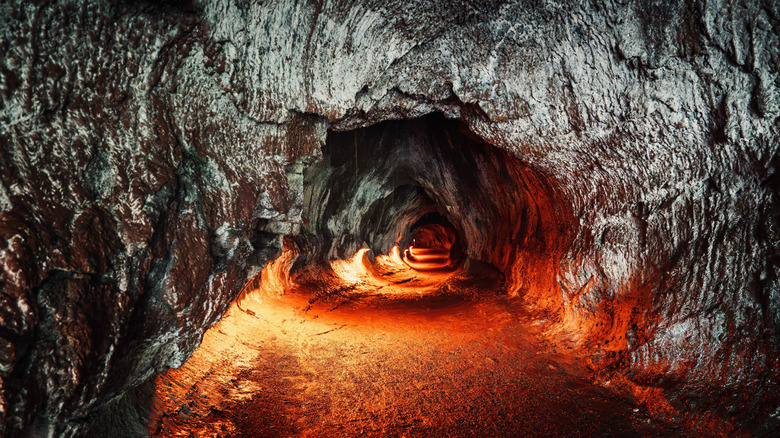This Incredible National Park Offers Explosive Natural Beauty In Paradise
One of the world's best places to put on your travel bucket list, visit Hawai'i and you'll likely be mesmerized by a spectacular display of colors. Whether you're witnessing a beautiful rainbow above Honolulu, taking in the lush green jungles of Kauai, or exploring the fiery reds and oranges that flow down the island's majestic volcanoes, there are plenty of incredible sights to see. And within the wild and incredible Hawai'i Volcanoes National Park — which has existed long before Hawaii became a state — you'll get to see some of the state's most sacred sites for Native Hawaiians firsthand.
The Hawaiian Islands were created after volcanic eruptions and magma flowed to the earth's surface at a hot spot. According Hawaiian oral tradition, the islands themselves are said to be the handiwork of the goddess Pele, who resides at the summit of Kilauea, one of the most active volcanoes in the world. Considered both a creator, giving birth to new land, and a destroyer, wrecking past creations with a fiery vengeance, locals believe Pele is ever-reshaping the landscape. While scientists agree that volcanic activity on Kauai has ceased, volcanoes on younger islands — including Maui and the "Big Island" — are still active. In fact, between 1983 and 2018, Kilauea's eruptions added over 437 acres of land to the Big Island.
Curious to see it with your own eyes? Your best option to reach Hawai'i Volcanoes National Park is by rental car after flying into the Big Island. The park is located approximately 30 miles south of Hilo, the island's largest city, and the closest major airport. Another option is to fly into Kailua-Kona and explore Highway 11, along the Slopes of Mauna Loa.
Exploring Hawai'i Volcanoes National Park
While you can find a strong presence of Hawaiian culture in Kapolei, an underrated and uncrowded city on Oahu, centuries of Hawaiian culture and the power of nature come together at Hawai'i Volcanoes National Park. Both converge at the Pu'uloa Petroglyphs, where smooth, pahoehoe lava was used by generations of Hawaiians to carve over 23,000 figures into the volcanic rock. Travelers recorded personal ties — including members of the traveling party, family ties, as well as positions in society. To reach them, walk 1.4 miles across a century-old lava field to the Pu'uloa, or "Hill of Long Life". Though the hike is easy, bring water, a hat, and proper footwear; it's not one you want to do in your flip-flops, as you'll be walking near and on sharp lava rock. Once you arrive, look out for cupules — small depressions in the rock where newborns' umbilical cords were placed to bless the child with a long and healthy life.
To witness how Hawaii's active volcanoes have dramatically changed the local landscape, don't miss hiking the Mauna Ulu trail. Here, you'll cross cooled lava fields and hike to the crater of an active volcano. Beginning in 1969, Mauna Ulu erupted on and off for over five years. Nearly 350 million cubic meters of molten lava flowed toward the sea burying everything in sight — including part of the original Chain of Craters road and a gorgeous ohi'a woodland. On your walk, you may even see volcanic activity, like steam emitting from the earth. Though it's not too steep, the trail isn't well marked. However, stacked stone markers called ahu mark the route. Please do not disturb the navigation tools.
Going beneath the surface
Underneath the surface of the Hawaiian Islands, you'll find a vast network of caves that once carried molten lava toward the earth's surface. Over time, these lava tubes cooled and formed natural tunnels that also served as key lifelines for Native Hawaiians, where they gathered naturally filtered water and also used them for protection.
One of the most famous lava tubes is Nāhuku, also called the Thurston Lava Tube. Although accessible 24 hours a day, the tube is only lit from 8:00 a.m. to 8 p.m. We also recommend arriving early, as parking spaces at Nāhuku and the nearby Kīlauea Iki Overlook lot are extremely limited. Also, keep in mind that the lava tube may close temporarily due to seismic activity, so watch out for any posted warnings. For another lava tube experience, visit the nearby Kazumura Cave, the world's longest lava tube.
Typical accommodation rates range from $348 to $538 per night, with vacation rental properties averaging roughly $261 per night. Travelers looking to stretch their budgets, or fall asleep deep in a high eucalyptus forest, can stay at the National Park's Namakanipiao Campground. With 10 charming cabins available for rent starting at $95 a night — in addition to the entrance fee — it's excellent value for money. Keep in mind, however, that the cabins do not have running water, and guests must use shared restrooms and showers. Alternatively, for a more comfortable stay at the park, the nearby Volcano House has full hotel rooms with views of the nearby forests or Halemaumau Crater. Both are just over an hour drive from the trailhead to Papakōlea Beach, one of the world's only green beaches, which offers a unique and scenic reward after a moderately challenging hike.


